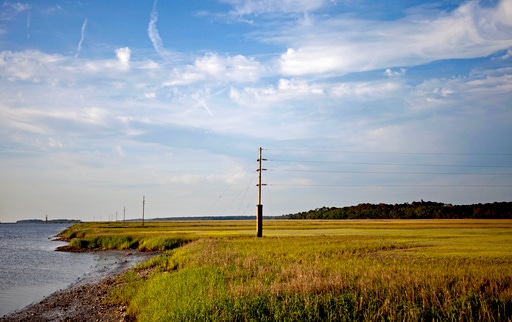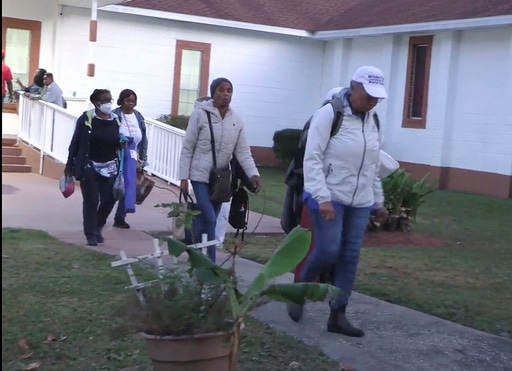Georgia’s Gullah-Geechee community seeks path forward after deadly dock collapse

FILE - In this May 16, 2013, file photo, a utility pole stands in the middle of a marsh at sunset on Sapelo Island, Ga., a Gullah-Geechee community. (AP Photo/David Goldman, File)[ASSOCIATED PRESS/David Goldman]
SAVANNAH, Ga. (AP) — The partial collapse of a ferry dock that claimed the lives of seven people attending a cultural festival has left a historic Black community in Georgia struggling with how to move forward.
The Gullah-Geechee residents of Sapelo Island were already facing a number of stressors: gentrification, tax hikes and an ongoing exodus of islanders to the mainland where there are schools and doctors, more plentiful jobs and greater conveniences.
The annual Cultural Day festival, held last weekend, was supposed to be a moment to forget their troubles and celebrate the history and culture of a community founded by formerly enslaved Black people. Before a metal walkway on the state-owned dock collapsed, sending people tumbling into the ocean, there were demonstrations of centuries-old traditions such as basket weaving, fish net casting and rice cultivation. A special music by the Gullah Geechee Ring Shouters filled the air.
Now, still stunned by the tragedy, residents of Sapelo’s Hogg Hummock community are riding a rollercoaster of emotions, worried that their formerly tranquil island life will be forever disrupted.
“Of course, they’re traumatized by the entire situation,” said Marquetta Goodwine, also known as Queen Quet, leader of the Gullah-Geechee nation. “Also, people are angry about something that was preventable.”
Civil rights attorney Ben Crump, who is representing relatives of three of the dead, has said he wants federal investigators, not officials from Georgia’s Department of Natural Resources, to lead the investigation.
In the meantime Reginald Hall, a Hogg Hummock resident and descendant of the island’s founders, can’t help but wonder if the deaths will tarnish Sapelo as a tourism destination.
“They came to the island to celebrate and they left off the island in body bags,” Hall said in an interview Sunday. “That speaks volumes and is going to tell people that our tourism industry is not safe.”
Roger Lotson, the only Black commissioner of McIntosh County, which includes Sapelo Island, is concerned about psychological trauma the residents might be feeling.
“Those that work on Sapelo, those that live on Sapelo, they have to constantly walk across a similar gangway as the one that collapsed. And I can’t help but think that that’s going to be in the back of some of their minds. But they have no choice.”
Small communities descended from enslaved island populations in the South — known as Gullah, or Geechee in Georgia — are scattered along the coastline from North Carolina to Florida. Scholars say their separation from the mainland is what helped them retain much of their African heritage, from their unique dialect to specialized skills and crafts.
The Gullah-Geechee’s distinct language was a result of slaves from various parts of west Africa wanting to be able to communicate with each other, said Anne C. Bailey, a professor of history at Binghamton University and author of “The Weeping Time: Memory and the Largest Slave Auction in American History.”
They also don’t often get credit for their contributions to the South’s culinary heritage, according to Bailey, who added that the Gullah-Geechee’s knowledge of how to cultivate rice ended up mainly benefiting slaveholders and slave traders who were also rice planters.
“They helped to develop the country and they helped to make these titans very rich,” Bailey said. “They received nothing.”
After the Civil War and Emancipation, some Gullah-Geechee were able to scrimp and save enough to buy land. Researchers estimate there are fewer than 30 incorporated historic Black towns left in the United States, a fraction of the more than 1,200 that existed from the 1880s to 1915. Some were decimated decades ago by white supremacists in attacks such as the Tulsa Race Massacre in 1921 and the Rosewood, Florida, massacre in 1923.
The biggest challenges to Sapelo now are development, political changes and increasing property tax rates that are pricing lower-income residents off their land.
In October 2023, Sapelo residents filed a lawsuit to stop a zoning law that would double the size of houses allowed from 1,500 to 3,000 square feet (139 to 279 square meters). There is a fear that wealthy outsiders will come in and drive natives out. Residents attempted last month to stop it via a referendum but a judge ordered a halt to the special election. Lotson is among the opponents of the rezoning.
“Even with me sitting on the board, they still don’t have much of a voice. … Fighting only gives us a slim chance of winning, but if we did not fight, we have no chance of winning,” Lotson said.
It’s hard to find examples of where infrastructure was improved or expanded without losing the Gullah-Geechee footprint. Bailey points to Georgia’s St. Simons Island, which used to be predominantly Black. Now it’s mostly a tourist draw with wealthy, non-Black residents, a more up-to-date pier and other amenities.
Goodwine questioned what good comes from gaining resources if it means having to give up land and heritage.
“What you have done is essentially given away your soul,” Goodwine said.
The best way for outsiders to support community members is to show up for the Gullah-Geechee people, Goodwine said. She runs a Gullah-Geechee website listing events and native-owned businesses and announcing petitions to sign.
“It is that love, it is that sincere giving to a community instead of just coming to see what you can extract out and then leave with it,” she said.
___
Tang reported from Phoenix.
Copyright 2024 The Associated Press. All rights reserved. This material may not be published, broadcast, rewritten or redistributed without permission.
